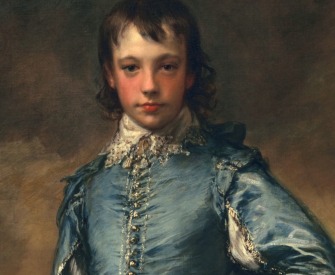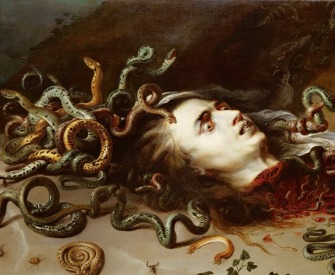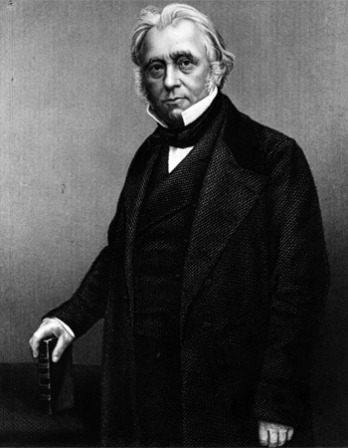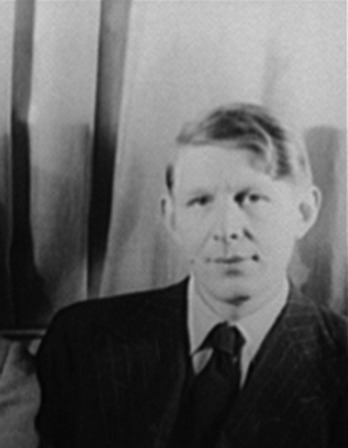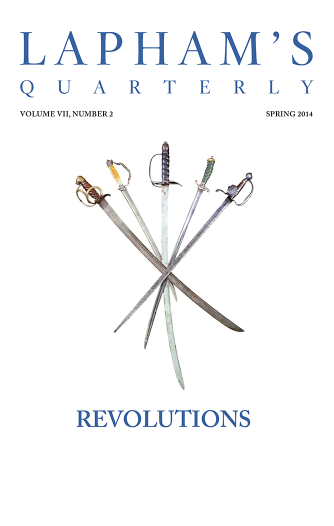Possessions, outward success, publicity, luxury—to me these have always been contemptible. I believe that a simple and unassuming manner of life is best for everyone, best both for the body and the mind.
—Albert Einstein, 1931Vanishing Act
Barbara Newhall Follett was a prodigy who transfixed the literary world—and then vanished.
By Paul Collins
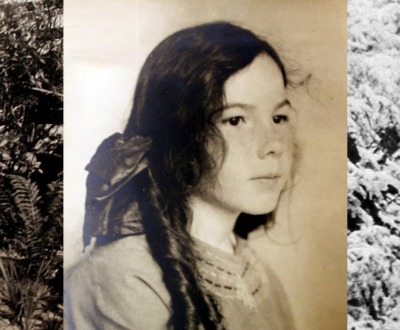
Family photographs of Barbara Newhall Follett. Via Farksolia.
Audio brought to you by Curio, a Lapham’s Quarterly partner
In a New Hampshire apartment during the winter of 1923, this typewritten notice was fastened squarely against a closed door:
Nobody may come into this room if the door is shut tight (if it is shut not quite latched it is all right) without knocking. The person in this room if he agrees that one shall come in will say “come in,” or something like that and if he does not agree to it he will say “Not yet, please,” or something like that. The door may be shut if nobody is in the room but if a person wants to come in, knocks and hears no answer that means there is no one in the room and he must not go in.
Reason. If the door is shut tight and a person is in the room the shut door means that the person in the room wishes to be left alone.
Through the door could be heard furious clacking and carriage returns: the sound, in fact, of an eight-year-old girl writing her first novel.
In 1923, typewriters were hardly a child’s plaything, but to those following the family of critic and editor Wilson Follett, it was a grand educational experiment. He’d already written of his daughter Barbara in Harper’s, describing a girl who by the age of three was consumed with letters and words. “She was always seeing A’s in the gables of houses and H’s in football goalposts,” he recalled. One day she’d wandered into Wilson’s office and discovered his typewriter.
“Tell me a story about it,” she demanded.
This was Barbara’s way of asking for any explanation, and after he demonstrated the wondrous machine, she took to it fiercely. A typewriter, her parents realized, could unleash a torrential flow of thoughts from a gifted child who still lacked the coordination to write in pencil.
“In a multitude of ways,” Wilson Follett reported, “we become more and more convinced of the expediency of letting the typewriter be, so far as a machine can, the center and genesis of the first processes.”
By five, Barbara was being homeschooled by her mother, and writing a tale titled The Life of the Spinning Wheel, the Rocking-Horse, and the Rabbit. Her fascination with flowers and butterflies bloomed from her typewriter into wild and exuberant poems and fairy tales. By 1922, at the age of seven, she was versifying upon music:
When I go to orchestra rehearsals,
there are often several passages for the
Triangle and Tambourine together.
When they are together,
they sound like a big piece of metal
that has broken in thousandths
and is falling to the ground.
The warning notice on her door the following year, though, marked a new project: young Barbara was attempting an entire novel. On some days the eight year old topped four thousand words. While her notes to her playmates and family overflowed with warmth, she was absolute in guarding her time to write. Neighboring children who didn’t understand were brusquely dismissed.
“You don’t understand why I have my work to do—because, at this particular time, you have none at all,” she snapped in a letter to a complaining playmate.
As 1923 passed into another year and yet another, she wrote and rewrote her tale of a girl who ventures into the woods and vanishes into nature. Friends, when needed, could always be imagined. “I pretend,” she once explained, “that Beethoven, the two Strausses, Wagner, and the rest of the composers are still living, and they go skating with me.”
There’s a peculiar comfort in imagining the companionship of great composers, for it is among them that a child prodigy is at home. Mozart rules the hopeful parent: homeschooled, composing harpsichord minuets at the age of five, playing the Viennese court at six, visiting Johann Christian Bach in London at age eight. He was one of the earliest celebrated child performers, and like Barbara, he was born to the profession—his father was a violin master. Then again, in some arts, there is almost an inevitability to the appearance of prodigies. Pablo Picasso’s charming Bullfight and Pigeons—drawn in 1890, when he was nine years old—can still elicit admiration at exhibitions and wise nodding. Ah, even then his talent shone through.
And yet others pass by more quietly. We do not dwell upon Bobby Fischer, even though by the time he was eight his mother was having to write newspaper ads to find him worthy chess partners. And no parent today buys Zerah flash cards for their young genius, though math prodigy Zerah Colburn was once as famous as Mozart. The son of a Vermont carpenter, Zerah’s talent was exhibited in 1810 at the age of five. Soon Zerah was gaining audiences with John Quincy Adams and letters of introduction from Washington Irving. By eight he mentally calculated in front of an audience that a Fermat number was not in fact prime, an almost unthinkable feat for even an adult mathematician. Yet the danger of Zerah’s overbearing and hapless father was obvious enough that Bostonians raised a fund to educate the boy in New England. His father turned the money down: there was a bigger fortune waiting on the road.
Today, we hear of Mozart, but not of Colburn. Little Barbara might skate with one, but not the other.
By 1926—many drafts, one baby sister, and one manuscript-destroying house fire later—her book had the title of The House Without Windows. It was, she explained, the tale of Eepersip, “a child who ran away from loneliness, to find companions in the woods—animal friends.” The tale stretched to over forty thousand words.
“Daddy and I are correcting the manuscript,” Barbara reported, “putting in and taking out, to copy it, and get it all ready to go to the printer.”
It was to be a small vanity job, but her father had a suggestion. He’d been working for a while with Knopf in New York; what if he passed it along to them? When Knopf’s response arrived addressed to Barbara—“a blue letter with the famous white borzoi seal”—she wrote to a friend what happened next:
I simply threw myself on the floor and screamed, either with fear for what it might contain, with joy for getting it at last, or with terrific excitement of the whole thing. There is a feeling, after you have been waiting a long time for anything, there is a feeling that, when it really comes, it must be impossible—
a dream—an optical illusion—a cross between those three things…
Now: “What doo zhoo fink???” It is Eepersip, The House Without Windows, my story, my story in New York, with the Knopfs, to be published!!... published!!!!!!!!
She had just turned twelve.
The House Without Windows appeared in February 1927 to overwhelming praise. “A Mirror of the Child Mind,” announced a New York Times headline: “the most authentic and unalloyed document of a transient and hitherto unrecorded phase in plastic intelligence…[a] truly remarkable little book.” They featured Barbara on the front page of that day’s Photogravure Picture Section, showing her correcting a set of galley proofs.
The Saturday Review of Literature found the book “almost unbearably beautiful.” It is not hard to see why. The opening lines evoke a fairy-tale isolation: “In a little brown shingled cottage on one of the foothills of Mt. Varcrobis, there lived with her father and mother, Mr. and Mrs. Eigleen, a little girl named Eepersip. She was rather lonely…” Eepersip emerges from the forest dressed in garlands to try to lure other children away, including her own younger sister:
“Look, I’d dress you like this, with ferns and flowers and butterflies…The bees gather honey from the flowers, which they would share with us.”
“Bees sting,” said Fleuriss, shrinking away; “they sting, and they hurt, Eepersip.”
Unable to convince anyone to join her outdoors—in her “house without windows”—Eepersip eventually disappears altogether, transformed into a wood nymph. It is a haunting tale that merges archetypal myth with a childhood desire to run away.
Soon Barbara was being asked to review the latest A.A. Milne for the papers, and H.L. Mencken wrote to her parents that “you are bringing up the greatest critic we heard of in America.” Follett’s next plan—“to become a pirate” and take to the sea for her new book—was announced in the Times.
Barbara was famous.
CONGRATULATIONS MY DEAR EEPERSIP, one telegram arriving at the Follett house read. YOU HAVE DONE WHAT MANY AN ADULT HAS FAILED TO DO.
But one critic was unimpressed.
“I can conceive of no greater handicap for the writer between the ages of nineteen and thirty-nine,” thundered Anne Carroll Moore in the New York Herald Tribune, “than to have published a successful book between the age of nine and twelve.”
The creator of the Children’s Room at the New York Public Library and one of the most powerful critics of children’s literature in America, Moore’s qualms were not with Barbara’s writing—“I have only words of praise for the story itself. The House Without Windows is exquisite”—but that it was published at all. “It is playing with fire,” she warned. “What price will Barbara have to pay for her ‘big days’ at the typewriter?”
Barbara needed to be outside playing with children her own age, Moore declared—and to grow up unburdened by early fame. “There are no satisfactions comparable to a free and spacious childhood with a clear title to one’s own good name at maturity.”
Yet there was some precedent for Barbara’s career. Seven years earlier, eleven-year-old Horace Wade published his thriller In The Shadow of Great Peril. More books followed, as well as encouraging letters from F. Scott Fitzgerald, and a job from William Randolph Hearst at the Chicago American. Wade’s writing lacked Follett’s aspirations—it was genre stuff, full of “chums” and dastardly outlaws—but it hinted that the child author could grow into success.
Others, though, were protected from their juvenilia. The most famous child author before Wade appeared just one year earlier, with Daisy Ashford and her ludicrous tale The Young Visiters: Or, Mr. Salteena’s Plan. Opening with the immortal line “Mr Salteena was an elderly man of 42 and was fond of asking peaple to stay with him,” the book was a classic of unintentional hilarity. It was harmless to Ashford; she’d written the book as a nine year old in 1890, and published it from the safe distance of twenty-nine years later. She became a celebrity for having been a child, but was not a child celebrity.
But Barbara was having none of this, and none of Moore’s criticism.
“It is surely very rash to slam down into the mud a childhood and a system of living that you know nothing about,” she responded in a fiery letter. “I am very much amused at the favorable reviews which are being written—I do not take them at all seriously—but I do take seriously an article which distorts into a miserable caricature my living, my education, my whole personality.”
To read her book “as if I were tyrannized over,” Barbara wrote, insulted her and her parents. “The book,” she insisted, “is an expression of joy—no more.”
Even as reviews rolled in, Barbara planned an odyssey she’d long dreamt of: going to sea as a ship’s crewman. That she was thirteen mattered little to her, and at length her parents found a lumber schooner to take her aboard as a passenger—one who insisted on doing chores.
Following her journey up to Nova Scotia, Follett’s next book, The Voyage of the Norman D, was written at a white heat. The voyage took place in July, the final manuscript was in Knopf’s hands by November, and the book was in stores by March. It is the work of an adult in the making: not just a charming prodigy, but an artist playing for keeps.
Follett sketches her first interview with the schooner’s captain with droll eloquence:
I spoke to the captain first of all, but very vaguely and dreamily, gazing about me—fascinated, enraptured, all the time. I looked at the long, huge booms, with the sails frapped closely round them; at the great, splendid masts; at the many ropes descending over blocks and made fast on belaying pins along the side of the boat; at the double and triple sheet blocks; and, above all, at the ratlines and shrouds, into which I longed to go up. The next minute I had jumped upon the spanker boom and crawled along to the very end, hanging slightly over the water, where I supported myself by one of the wire lifts.
“Oh,” said the captain, “I see you’re a girl as likes to climb around.”
The book’s confidence stunned reviewers on both sides of the Atlantic. Follett was no longer a cute “child authoress”: she was an author.
“Its ingeniousness is preserved, yet embellished, by a literary craftsmanship which would do credit to an experienced writer,” the Times Literary Supplement marveled from London. The Saturday Review featured her book alongside Dorothy Parker’s latest, and declared it “a fine, sustained, and vivid piece of writing.” And yet, mused the New York Times, “Miss Barbara Newhall Follett celebrated her fourteenth birthday just twelve days before the publication.”
But in that week before publication, Wilson Follett delivered devastating news. He’d recently turned forty, and—in a plot development he’d have struck down as painfully trite in any novel—he was leaving Barbara and her mother Helen for a younger woman.
“You say Helen needs me,” Barbara pleaded to her father, “and right you are, but I need you, too.” But at the moment of her greatest triumph, Barbara was abandoned by the man who had fostered her ambitions.
Wilson left them with little money. At first, Helen tried to spin necessity into adventure: they would take their typewriters to sea, sail to Tahiti, and write books! But by September 1929, Barbara found herself stranded and alone with family friends in Los Angeles. It was unbearable: she fled to San Francisco, hid in a hotel, and wrote poetry. But she’d been reported as a runaway, and when police burst into her room, they narrowly kept her from escaping through the window.
“I loathe Los Angeles,” she explained to reporters.
The story made national news; a Times headline reminded readers, “Case of Barbara Follett Recalls Feats of Chopin, Mozart, and Others.” Helen and Barbara were reunited in New York, but their finances were so dire that upon turning sixteen in March 1930, Barbara had to find work. Her timing was awful, coming months after the Wall Street crash. After a course in shorthand and business typing—a “decidedly more tawdry use of its magic,” she mused—Barbara was getting up early every morning to ride the subway to a secretarial job.
“My dreams are going through their death flurries,” she wrote that June. “I thought they were all safely buried, but sometimes they stir in their grave, making my heartstrings twinge. I mean no particular dream, you understand, but the whole radiant flock of them together—with their rainbow wings, iridescent, bright, soaring, glorious, sublime. They are dying before the steel javelins and arrows of a world of Time and Money.”
Improbably, she kept writing: she took to waking up early before work to toil on a new book, Lost Island. Set around a New York couple who get shipwrecked on a deserted island, the book pivots on a dilemma: after they’re discovered, the woman doesn’t want to go back. Lost Island’s opening lines show a teenaged author turned older and abraded by Manhattan:
Not even a cat was out. The rain surged down with a steady drone. It meant to harm New York and everyone there. The gutters could not contain it. Long ago they had despaired of the job and surrendered. But the rain paid no attention to them…New York people never lived in houses or even in burrows. They inhabited cells in stone cliffs. They timed the cooking of their eggs by the nearest traffic light. If the light went wrong, so did the eggs…
“I don’t like civilization,” she said, to the rain.
By 1934, Follett had written her third and fourth books—Lost Island, and a brisk travelogue on the Appalachian Trail called Travels Without a Donkey. But worn down by six years without the encouragement of a father or an editor, the manuscripts finally stopped. Instead, she found a kindred soul in an outdoorsman named Nickerson Rogers, and they eloped.
America’s next great novelist was now without a high-school degree, without work, and a teen bride. Yet she was not unhappy—at first. She backpacked through Europe, and between secretarial jobs in New York and Boston, she discovered dance classes. She took some summers off to travel west for dance classes at Mills College, which she loved: it was a taste of the college life that she’d been denied. But returning to her husband in Brookline, Massachusetts, in late 1939, she was shaken once again, worse even than by her father’s abandonment.
“There is somebody else…” she wrote to a friend. “I had it coming to me, I know.” Her despair was so keen that she could only rest with the help of “sleeping stuff.” Soon her correspondence darkened ominously: “On the surface things are terribly, terribly calm, and wrong…I still think there is a chance that the outcome will be a happy one, but I would have to think that anyway, in order to live; so you can draw any conclusions you like from that!”
The conclusion to be drawn was perhaps the worst one possible. On the evening of December 7, 1939, she and Nick quarreled, and by a friend’s account she left later that evening.
She never returned.
Some prodigies flourish, some disappear. But Barbara Rogers did leave one last comment to the world about writing—a brief piece in a 1933 issue of Horn Book that earnestly recommends that parents give their own children typewriters. “Perhaps there would simply be a terrific wholesale destruction of typewriters,” she admits. “An effort would have to be made to impress upon children that a typewriter is magic.” So is the child at it, but Follett doesn’t hint that she had now been spending years battling poverty. The father who gave her that typewriter doesn’t appear in the piece, either. She’d been so angry at him in one letter that she snapped, “He isn’t what you’d call a man.”
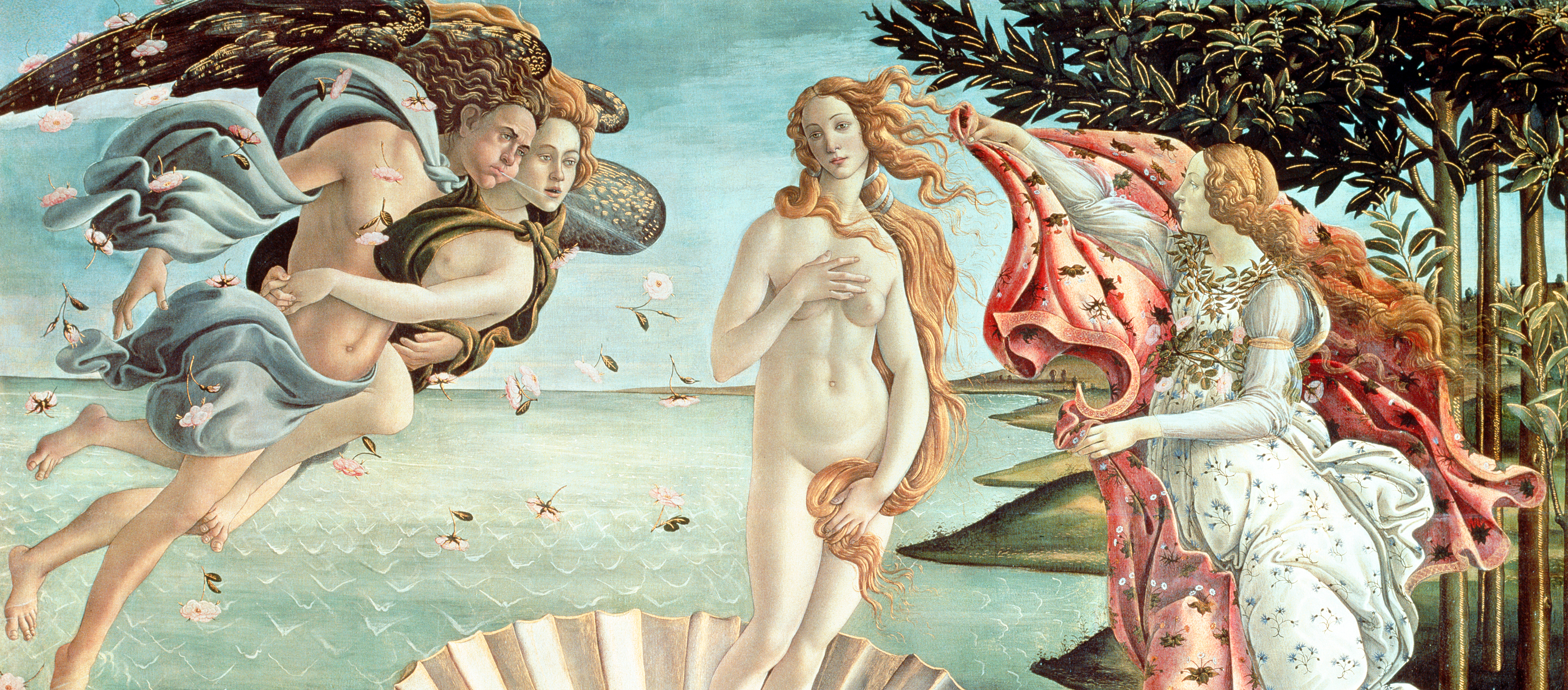
The Birth of Venus, by Sandro Botticelli, c. 1485. Uffizi Gallery, Florence.
But her tribulations were as appallingly timeless as the fairy tales that she so loved. Decades later, Bobby Fischer would be left by his mother at seventeen to essentially fend for himself, and while that may not have created his famed eccentricity, it hardly helped. Nor was the fact that she’d allowed him to drop out of school at the age of sixteen.
And what of the promising mathematical prodigy, Zerah Colburn? After traveling to Europe to be exhibited by his father, the boy did not return for twelve years—his father now dead overseas, and Zerah himself nearly broke and his talents squandered. Financial straits might have led to his publication in 1833 of A Memoir of Zerah Colburn, Written by Himself. Unknown today, it is the first child-celebrity memoir. Colburn was so alienated from his existence that he wrote it in the third person—as if he too were gawking at this famed phenomenon called Zerah.
A washed-up performer at nineteen, he arrived back in Vermont and knocked on the door of his former home. “They inquired of an elderly woman who was at the door, if she knew where the widow Colburn lived? She replied that she was the woman…his own mother was as ignorant of the child she had nursed and provided for until he was six years old, as if she had never seen him before.”
Zerah Colburn had also disappeared—so thoroughly that he couldn’t reappear even when he wanted to.
Nick waited two weeks to go to the police, and another four months to request a missing-persons bulletin: he claimed he was waiting for Barbara to return. Nobody in Boston’s morgue matched her, and the bulletin, issued under her married name, went unnoticed by the press:
Brookline. 139 4-22-40 3:38 pm Maccracken. Missing from Brookline since Dec. 7, 1939, Barbara Rogers, married, age 26, 5-7, 125, fair complexion, black eyebrows, brown eyes, dark auburn hair worn in a long bob, left shoulder slightly higher than right. Occasionally wears horn-rimmed glasses.
It wasn’t until 1966, when Helen coauthored a slim academic study on her daughter, that the press realized Barbara Newhall Follett was missing at all.
In the intervening years, Wilson Follett wrote a peculiar anonymous essay for The Atlantic—“To a Daughter, One Year Lost,” in May 1941—which expressed muted guilt and amazement: “Could Helen Hayes be lost for ten days without a trace? Could Thomas Mann? Could Churchill? And now it is getting on toward forty times ten days…”
Helen, belatedly discovering how little Nickerson Rogers had looked for Barbara, spent 1952 urging police to seek someone now missing for thirteen years. “There is always foul play to be considered,” she hinted to Brookline’s police chief. To Nickerson, she was blunter: “All of this silence on your part looks as if you had something to hide concerning Barbara’s disappearance…You cannot believe that I shall sit idle during my last few years and not make whatever effort I can to find out whether Bar is alive or dead, whether, perhaps, she is in some institution suffering from amnesia or nervous breakdown.”
She never found her.
Extraordinary young talents are all the more dependent on the most ordinary sustenance. But instead of a home and a college education, what Barbara Follett got was author copies and yellowing newspaper clippings. This girl—who should have been America’s next great literary woman—was abandoned by the two men she trusted, and her fame forgotten by a public that she never trusted in the first place. Her writings, out of print for many decades, only exist today in six archival boxes at Columbia University’s library. Taken together, they are the saddest reading in all of American literature.
Then again, her work always was about escape. Her mysterious disappearance echoes with the final words of The House Without Windows, when the lonely Eepersip finally vanishes forever into the woods.
“She would be invisible forever to all mortals, save those few who have minds to believe, eyes to see,” Follett wrote. “To these she is ever present, the spirit of Nature—a sprite of the meadow, a naiad of lakes, a nymph of the woods.”
